The Three Phase Micro Inverter Market is estimated to be valued at USD 284.0 million in 2025 and is projected to reach USD 897.9 million by 2035, registering a compound annual growth rate (CAGR) of 12.2% over the forecast period. This market demonstrates a clear trajectory of steady year-on-year growth, beginning with USD 159.7 million in 2020 and rising incrementally to USD 284.0 million by 2025, reflecting increasing adoption of distributed solar energy solutions and a shift toward smart, energy-efficient inverters. From 2025 to 2030, the market enters a scaling phase, with revenues climbing from USD 284.0 million to approximately USD 505.0 million, supported by accelerating residential and commercial solar installations, government incentives, and technological advancements that improve energy conversion efficiency.
Post-2030, the market continues its growth but at a slightly moderated pace, transitioning into a consolidation phase. By 2035, the market value will reach USD 897.9 million as adoption matures and leading players strengthen their presence through product innovation and regional expansion. Geographically, Asia Pacific leads demand growth due to aggressive renewable energy targets, while North America and Europe maintain steady adoption fueled by energy efficiency regulations.
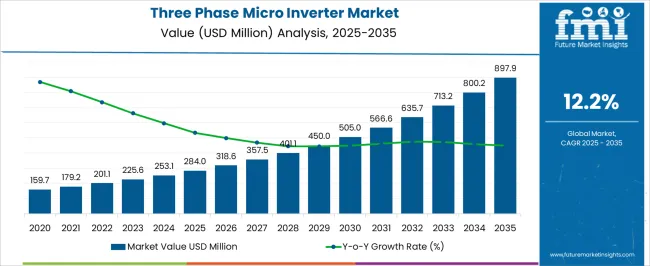
| Metric | Value |
|---|---|
| Three Phase Micro Inverter Market Estimated Value in (2025 E) | USD 284.0 million |
| Three Phase Micro Inverter Market Forecast Value in (2035 F) | USD 897.9 million |
| Forecast CAGR (2025 to 2035) | 12.2% |
The Three Phase Micro Inverter market is experiencing accelerated growth due to the rising integration of distributed energy resources, expanding solar infrastructure, and the global push toward decentralized power generation. Strong emphasis on grid stability, improved energy conversion efficiency, and minimized system downtime has made three phase micro inverters an attractive solution across utility-scale and commercial applications.
Industry developments and energy transition policies have driven demand for modular and scalable inverter architectures that optimize performance in varied environmental conditions. Key stakeholders across the energy and power sectors are investing in next-generation inverter technologies that offer remote monitoring, better fault tolerance, and compliance with updated grid codes.
These trends are being reinforced by increasing electricity consumption, growing commercial solar deployments, and supportive government incentives for renewable energy adoption. As the need for advanced grid-tied and intelligent solar systems intensifies, the Three Phase Micro Inverter market is expected to maintain a strong upward trajectory, especially in regions actively modernizing their electrical infrastructure.
The three phase micro inverter market is segmented by connectivity, application, and geographic regions. By connectivity, the three phase micro inverter market is divided into On grid and Standalone. In terms of application, the three-phase micro inverter market is classified into Commercial & industrial and Residential. Regionally, the three phase micro inverter industry is classified into North America, Latin America, Western Europe, Eastern Europe, Balkan & Baltic Countries, Russia & Belarus, Central Asia, East Asia, South Asia & Pacific, and the Middle East & Africa.
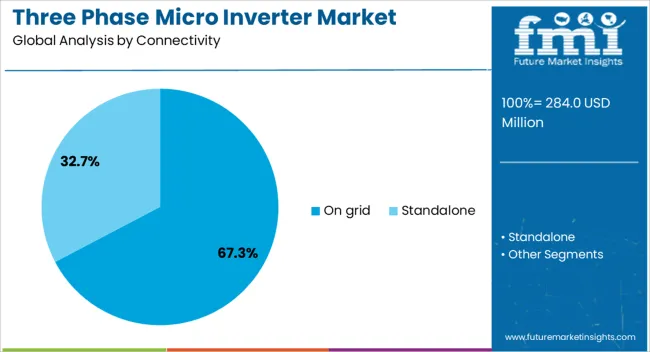
The on grid connectivity segment is projected to account for 67.3% of the Three Phase Micro Inverter market revenue share in 2025, making it the leading connectivity configuration. This dominance has been attributed to the increasing integration of solar photovoltaic systems into the main power grid, particularly in urban and industrial zones. The on grid architecture allows excess power to be fed back into the grid, promoting energy efficiency and cost savings, which has been prioritized by commercial and governmental users.
Its compatibility with net metering policies and regulatory incentives has further solidified its position in developed and emerging markets. Industry insights highlight that on grid systems offer enhanced monitoring, real-time energy feedback, and minimal maintenance compared to off grid setups.
As energy utilities and businesses focus on achieving sustainability targets, on-grid three-phase micro inverters have become essential for grid stabilization and efficient energy dispatch.

The commercial and industrial application segment is anticipated to contribute 61.5% of the Three Phase Micro Inverter market revenue share in 2025, positioning it as the leading end use segment. This leadership has been influenced by the rapid deployment of solar energy solutions across business parks, manufacturing facilities, warehouses, and institutional buildings. Businesses are increasingly investing in on-site solar installations to reduce operating costs, improve energy independence, and meet environmental regulations.
The scalability, high performance, and lower downtime offered by three phase micro inverters have made them ideal for commercial-scale use, where energy reliability and safety are non-negotiable. The segment’s growth is further driven by the demand for smart energy systems that offer real-time diagnostics, remote control, and seamless integration with building energy management systems.
Favorable policy frameworks, tax credits, and green building certifications are also encouraging adoption within the commercial and industrial space.
The three phase micro inverter market is witnessing steady growth as solar PV installations expand in commercial, industrial, and residential sectors. Micro inverters convert DC power from individual solar panels into AC, enhancing energy yield and system reliability. Rising adoption of distributed solar systems, smart grid integration, and performance monitoring drives demand. Markets in North America and Europe lead due to incentives and favorable policies, while Asia-Pacific is emerging with large-scale solar projects. Manufacturers focus on high-efficiency designs, modular solutions, and reliability to meet diverse installation needs.
Three phase micro inverters are increasingly preferred in commercial and industrial solar setups due to their ability to optimize energy output from each panel. Unlike traditional string inverters, these devices minimize the impact of shading, panel mismatch, and module-level failures, improving overall system performance. Businesses prioritize energy efficiency, reduced downtime, and scalable solutions for large rooftop or ground-mounted installations. Growing awareness of electricity cost savings, integration with energy management systems, and improved monitoring capabilities contribute to widespread adoption. As demand for distributed energy grows, these inverters provide a flexible and reliable solution, supporting both retrofit and new installations.
Energy conversion efficiency and operational reliability are critical factors for three phase micro inverters. Manufacturers invest in durable components resistant to temperature fluctuations, voltage surges, and environmental stress. Advanced monitoring features allow real-time tracking of individual panel performance, helping detect faults early and maximize energy harvest. Remote diagnostics and software-based performance optimization enhance customer satisfaction and reduce maintenance costs. Reliable inverters extend system life and protect investments in renewable energy projects. Suppliers emphasizing quality certifications, warranty support, and performance transparency gain trust from solar installers, EPC companies, and end-users.
Residential solar adoption is driving micro inverter demand, particularly in urban areas with rooftop constraints or partial shading. Homeowners prefer systems that offer panel-level control, simplified installation, and compatibility with smart home energy management solutions. Incentives, net metering policies, and growing awareness of renewable energy benefits encourage residential uptake. Lightweight, modular inverters allow easy integration into smaller rooftop systems. Local distributors and service providers focus on training installers and providing technical support to increase adoption. As more households shift toward self-generation and energy independence, residential solar systems provide a significant growth opportunity for three phase micro inverters.
The market is highly competitive with global and regional players offering varying levels of efficiency, reliability, and cost. Supplier relationships, component sourcing, and production capacity influence pricing and availability. Fluctuating semiconductor prices and international logistics challenges can impact manufacturing timelines. Companies differentiate through product performance, warranties, and customer support. Strategic partnerships with solar developers, distributors, and energy service providers help increase market reach. Innovation in modular design, thermal management, and compatibility with multiple panel types allows manufacturers to maintain an edge. Maintaining consistent supply while addressing evolving customer expectations remains essential for sustaining growth.
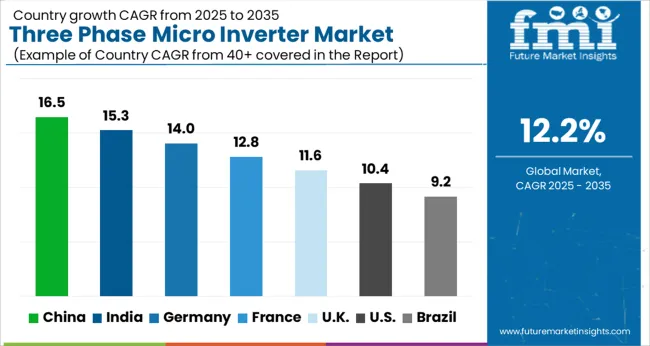
The global three phase micro inverter market is projected to grow at a CAGR of 12.2%, driven by increasing adoption of solar energy systems and renewable energy integration. China leads the market with a 16.5% growth rate, supported by large-scale solar installations and government incentives. India follows at 15.3%, fueled by growing residential and commercial solar deployments. Germany shows steady growth at 14%, leveraging advanced solar technologies and renewable energy policies. The UK and USA record growth rates of 11.6% and 10.4%, respectively, reflecting steady demand in residential and commercial solar sectors. This report includes insights on 40+ countries; the top countries are shown here for reference.
The three phase micro inverter market in China is growing at 16.5%, driven by the rapid adoption of solar photovoltaic systems, increasing energy demand, and supportive government policies for renewable energy. The rising focus on smart grid integration, energy efficiency, and decentralized power generation is further boosting demand for advanced inverter technologies. Manufacturers in China are investing in R&D to improve conversion efficiency, reliability, and durability of micro inverters to cater to residential, commercial, and industrial applications. The growing emphasis on reducing carbon emissions and transitioning to sustainable energy solutions has accelerated the installation of solar systems equipped with three phase micro inverters. Additionally, favorable incentives, subsidies, and renewable energy targets set by the government are creating a favorable environment for market growth. With continuous technological advancements and increasing solar PV adoption, China remains a major hub for three phase micro inverter demand.
The three phase micro inverter market in India is expanding at 15.3%, driven by the country’s renewable energy targets, increasing residential and commercial solar installations, and growing awareness of energy efficiency. Adoption of three phase micro inverters is rising due to their enhanced power conversion efficiency, reliability, and ability to support distributed energy generation. Government initiatives, such as subsidies for rooftop solar projects and solar parks, are encouraging the use of advanced inverter technologies. Key end-use sectors, including residential complexes, commercial buildings, and small-scale industries, are investing in micro inverters to optimize energy output and reduce grid dependency. Domestic and international manufacturers are focusing on local production, technological upgrades, and cost-effective solutions to meet market demand. With India’s emphasis on sustainable energy and solar capacity expansion, the demand for three phase micro inverters is expected to maintain a strong growth trajectory.

Three phase micro inverter market in Germany is growing at 14%, supported by the country’s commitment to renewable energy, solar PV adoption, and energy efficiency initiatives. Residential, commercial, and industrial sectors are increasingly adopting three phase micro inverters to maximize energy conversion and improve grid stability. Germany’s strict energy regulations and focus on reducing carbon emissions drive the deployment of advanced inverter technologies. Manufacturers are investing in R&D to enhance product performance, reliability, and compatibility with smart grid systems. The growing trend of decentralized power generation and rooftop solar installations further supports market growth. In addition, government incentives for renewable energy adoption and energy storage systems create a favorable market environment. Germany’s emphasis on clean energy, efficiency, and sustainable power infrastructure ensures a steady and growing demand for three phase micro inverters.
The three phase micro inverter market in the United Kingdom is expanding at 11.6%, driven by increasing solar PV installations, energy efficiency initiatives, and government incentives for renewable energy. Residential and commercial sectors are adopting micro inverters to enhance energy conversion efficiency, improve system reliability, and support distributed energy generation. Manufacturers are focusing on product innovation, including smart and connected inverter solutions, to meet growing market requirements. Policies promoting clean energy, carbon reduction, and renewable energy adoption further encourage the use of advanced inverter technologies. As solar PV adoption grows and energy infrastructure modernizes, the demand for three phase micro inverters in the UK is expected to rise steadily, offering opportunities for both domestic and international suppliers.
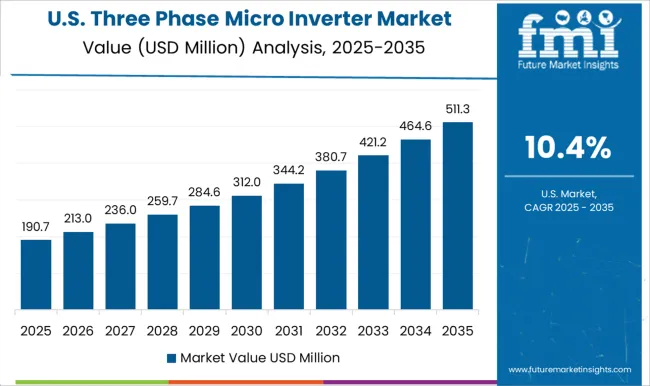
The three phase micro inverter market in the United States is growing at 10.4%, driven by increasing solar installations, renewable energy adoption, and demand for efficient energy conversion. Residential, commercial, and industrial sectors are integrating micro inverters to improve energy output, reliability, and grid stability. Government incentives, renewable energy policies, and clean energy targets encourage investment in advanced inverter technologies. Manufacturers are focusing on R&D to enhance conversion efficiency, durability, and smart connectivity of micro inverters. Rising awareness of sustainability and the benefits of decentralized power generation contribute to market growth. With continuous technological advancements, supportive regulations, and growing solar PV adoption, the United States presents a significant opportunity for three phase micro inverter suppliers.
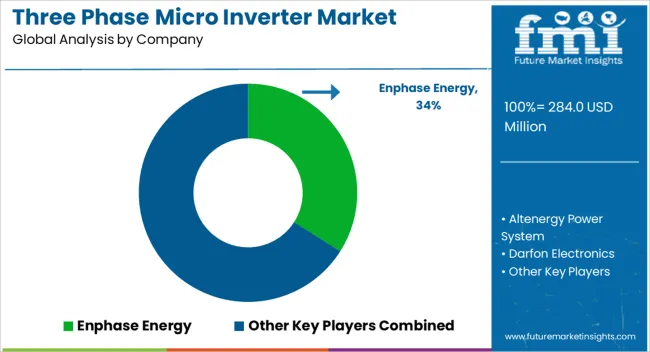
Competition in the three phase micro inverter space is ultimately decided by installer experience and support responsiveness. APsystems and Hoymiles are widely regarded as the dependable pair, backed by broad three phase portfolios, strong thermal behavior, and warranties that calm lenders. Growatt New Energy is favored by teams seeking a single toolkit, since inverters, monitoring, and service are delivered as a joined package. Darfon Electronics, TSUNESS, Envertech, and Northern Electric Power Technology are positioned around specific power classes and regional codes, with compatibility maintained for high current modules and rapid shutdown rules. Sparq Systems and Dongguan Maywah are often chosen in cost sensitive bids, where lighter chassis, clear labeling, and quick mounting cut site time. Differentiation is now found in steady output without derating at heat, reactive power control, arc fault protection, and fleet portals that surface string level issues before truck rolls. Price pressure remains real, so lifetime cost, swap logistics, and distributor credit terms often decide awards. The next wave is expected to feature higher input currents, longer warranties, and open APIs that keep portfolio data easy to use.
| Item | Value |
|---|---|
| Quantitative Units | USD 284.0 Million |
| Connectivity | On grid and Standalone |
| Application | Commercial & industrial and Residential |
| Regions Covered | North America, Europe, Asia-Pacific, Latin America, Middle East & Africa |
| Country Covered | United States, Canada, Germany, France, United Kingdom, China, Japan, India, Brazil, South Africa |
| Key Companies Profiled | APsystems, Darfon Electronics, Dongguan Maywah, Envertech, Growatt New Energy, Hoymiles, Northern Electric Power Technology, Sparq System, and TSUNESS |
| Additional Attributes | Dollar sales by type including string microinverters, standalone microinverters, and hybrid microinverters, application across residential, commercial, and utility-scale solar installations, and region covering North America, Europe, and Asia-Pacific. Growth is driven by increasing adoption of solar energy, demand for efficient power conversion, and expansion of distributed energy systems. |
The global three phase micro inverter market is estimated to be valued at USD 284.0 million in 2025.
The market size for the three phase micro inverter market is projected to reach USD 897.9 million by 2035.
The three phase micro inverter market is expected to grow at a 12.2% CAGR between 2025 and 2035.
The key product types in three phase micro inverter market are on grid and standalone.
In terms of application, commercial & industrial segment to command 61.5% share in the three phase micro inverter market in 2025.






Full Research Suite comprises of:
Market outlook & trends analysis
Interviews & case studies
Strategic recommendations
Vendor profiles & capabilities analysis
5-year forecasts
8 regions and 60+ country-level data splits
Market segment data splits
12 months of continuous data updates
DELIVERED AS:
PDF EXCEL ONLINE
Commercial Three Phase Micro Inverter Market Size and Share Forecast Outlook 2025 to 2035
Three Wheeled Motorcycle Market Size and Share Forecast Outlook 2025 to 2035
Three-Wheel E-Scooter Market Growth - Trends & Forecast 2024 to 2034
Three Piece Cans Market
Three Phase Commercial Voltage Regulator Market Size and Share Forecast Outlook 2025 to 2035
Three Phase Residential Voltage Regulator Market Size and Share Forecast Outlook 2025 to 2035
Three Phase Recloser Market Size and Share Forecast Outlook 2025 to 2035
Three Phase Green Power Transformer Market Size and Share Forecast Outlook 2025 to 2035
Three Phase Residential Power Conditioner Market Size and Share Forecast Outlook 2025 to 2035
Three Phase Shunt Reactor Market Size and Share Forecast Outlook 2025 to 2035
Three Phase Power Device Analyzer Market Size and Share Forecast Outlook 2025 to 2035
Three Phase Inverter Market Size and Share Forecast Outlook 2025 to 2035
Three Phase String Inverter Market Size and Share Forecast Outlook 2025 to 2035
On-grid Three Phase PV Inverter Market Size and Share Forecast Outlook 2025 to 2035
Electric Three Wheeler Market - Trends & Forecast 2025 to 2035
Automotive Three Way Catalytic Converter Market Size and Share Forecast Outlook 2025 to 2035
Air Cooled Three Phase Home Standby Gensets Market Size and Share Forecast Outlook 2025 to 2035
Standalone Three Phase PV Inverter Market Size and Share Forecast Outlook 2025 to 2035
Phase Shifting Transformer Market Size and Share Forecast Outlook 2025 to 2035
Dual-Phase Cleanser Market Size and Share Forecast Outlook 2025 to 2035

Thank you!
You will receive an email from our Business Development Manager. Please be sure to check your SPAM/JUNK folder too.
Chat With
MaRIA